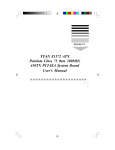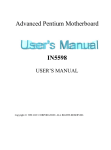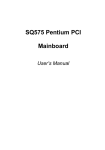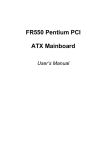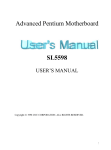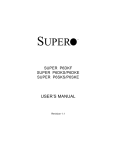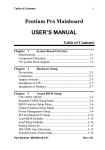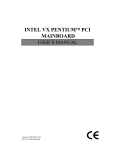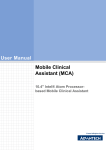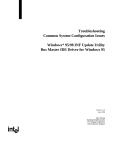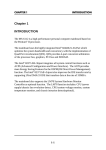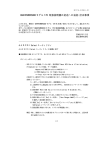Download Tyan Computer TYAN S1668 Network Card User Manual
Transcript
Revision 1.2 TYAN S1668 Dual Pentium Pro ATX 440FX PCI-ISA System Board User's Manual Table Of Contents 1. Introduction....................................................................... 3 1.1 Overview................................................................3 1.2 Hardware Specifications..........................................4 1.3 Software Specifications.......................................... 5 1.4 Environment........................................................... 5 2. Board Installation.............................................................. 6 2.1 Unpacking.............................................................. 6 2.2 Installation.............................................................. 6 3. S1668 On Board Resource Settings................................. 7 3.1 S1668Board Layout & Jumper Locations................ 7 3.2 Quick Reference for Jumpers.................................. 8 3.3 CMOS RTC............................................................11 3.4 Speaker Connector.................................................. 11 3.5 Turbo Switch.......................................................... 11 3.6 Turbo LED Connect................................................ 11 3.7 Reset Connector..................................................... 12 3.8 Flash EPROM Jumpers.......................................... 12 3.9 CMOS & Password Reset...................................... 12 3.10 DRAM Installation................................................ 13 3.11 CPU Installation.................................................... 15 3.12 VRM Installation................................................... 16 3.13 Peripheral Device Installation................................. 16 3.14Connecting The Power Supply............................... 16 4. BIOS Configuration........................................................... 17 4.1 Entering Setup....................................................... 17 4.2 Control Keys......................................................... 18 4.3 Getting Help........................................................... 19 4.4 The Main Menu...................................................... 19 4.5 Standard CMOS Setup Menu...................................21 4.6 BIOS Features Setup.............................................. 24 4.7 Chipset Features Setup............................................ 27 4.7.1 Power Management Setup........................ 28 4.8 PCI Slot Configuration.............................................30 4.9 Integrated Peripherals............................................. 32 4.10 Load Setup Defaults.............................................. 33 4.11 IDE HDD Auto Detection..................................... 35 4.12 Save & Exit Setup................................................. 35 5. Flash Writer Utility............................................................ 36 5.1 The Flash Memory Writer Utility Screen...................38 6. System Resources............................................................. 39 6.1 Timer & DMA Channel Map................................... 39 6.2 Interrupt Map......................................................... 39 S1668-ATX-001 http://www.tyan.com 2 1. Introduction 1.1 Overview The S1668 is a quality, high performance dual processor mainboard based on the powerful Intel Pentium Pro microprocessors. This mainboard is designed around the latest and fastest Intel 440FX chipset and can support CPU speeds of 150MHz through 200MHz. The S1668 supports EDO memory, Burst EDO, ECC and memory parity checking.The S1668's PCI Local Bus provides high performance capabilities that are ideal for a wide range of demanding applications such as: CAD, CAM, CAE, networking, multi-user environments, database management, desktop publishing, image processing and 3D animation. This integrated system board achieves the highest reliability and features the industry standard "ATX" form factor. Some of the features included are: on-board dual channel PCI IDE, on-board floppy controller, on-board high speed I/O, Universal Serial Bus and on-board PS/2 mouse connector. Flexibility and expandibility have been designed into the S1668. With I/O and drive controller support built on-board, the five PCI and three ISA (One ISA and one PCI as a shared slot) slots are free for add-on expansion cards. With eight SIMM sockets, the S1668 can provide a very flexible memory configuration of 8MB to 1024MB of RAM. With the S1668's support for dual Pentium Pro processors, you can start a system with just one CPU, and later add another, when more processing power is required. Remember to take a look at Tyan Computers web site located at http://www.tyan.com. Here you can find information on all of Tyan's products along with FAQ's, distributors list, drivers and CMOS setting explanations. S1668-ATX-001 http://www.tyan.com 3 1.2 Hardware Specifications/Features CPU Intel Pentium Pro 150 thru 200 MHz (Socket 8) (Single or Dual CPU configuration) Coprocessor On-chip floating point unit Speed 60/66 MHz system bus 30/33 MHz PCI bus 7.5/8.33 MHz ISA bus speed DRAM 4 double banks of 72 pin SIMM sockets Supports 5V or 3.3V memory Supports BEDO(Burst Extended Data Out) Supports EDO(Extended Data Out) DRAMs Supports ECC(Error Correcting Code)w/ parity Supports Fast Page Mode DRAMs Supports 8MB to 1024MB of DRAMs L2 Cache 256/512KB 2nd level cache in CPU EIDE Controller Primary and secondary PCI EIDE channels on board for support of up to four EIDE Mode 0 through Mode 4 drives.Supports DMA mode 1 and 2. Enhanced I/O Multi-mode bi-directional parallel port that supports standard, EPP and ECP modes. Supports 16550 compatible UARTS for on-board high speed serial ports. Support for an IrDA compliant InfraRed interface. On-board floppy controller. On-board USB(Universal Serial Port). Mouse On-board PS/2 mouse connector. I/O Bus Slots 5 Master/Slave PCI-Bus 3 ISA Bus (One ISA and one PCI shared slot) S1668-ATX-001 http://www.tyan.com 4 1.3 Software Specifications BIOS Award or AMI BIOS AT CMOS setup, BIOS/CHIPSET setup, and hard disk utility included. Support for easy BIOS upgrades with flash EEPROM chip. O.S. Operates with MS-DOS, Windows 3.x, Windows for Work Groups 3.x, Windows 95, Windows NT, OS/2, Novell Netware, Novell UnixWare 1.1 and SCO Unix. 1.3 Environment Ambient Temperature Relative Humidity Altitude Vibration Voltage 0 to +50 C (operating) 0 to +85% (operating) 0 to 10,000 feet (operating) 0 to 1,000 Hz 4.9 to 5.2 V Information presented in this publication has been carefully checked for reliability; however, no responsibility is assumed for inaccuracies. The information contained in this document is subject to change without notice. Trademarks Award BIOS/Flash are trademarks of Award Software International Inc. AMI BIOS is a trademarks of American Megatrends Inc. IBM,PC,AT,PS/2 are trademarks of IBM Corporation INTEL,Pentium Pro are trademarks of Intel Corporation. Copyright c 1996 TYAN Computer Corp. S1668, Titan Pro ATX. S1668-ATX-001 http://www.tyan.com 5 2. Board Installation 2.1 Unpacking The mainboard package should contain the following: S1668 Mainboard One IDE 40 pin cable One 34 pin floppy cable User's Manual Optional VRM(Voltage Regulator Module) The mainboard contains sensitive electric components which can be easily damaged by static electricity, so the mainboard should be left in its original packaging until it is ready to be installed. With the power supply pluged in and turned off touch an unpainted area of the system chassis imedietly before handling the mainboard or any component. Doing so discharges the static charge your body may have built. After opening the mainboard carton, extract the system board holding it by its edges ,and place it only on a grounded anti-static surface, component side up. Inspect the board for damage. Press down on all of the socket IC's to make sure that they are properly seated. Do this only with the board placed on an anti-static mat. Do not touch the bottom of the board. DO NOT APPLY POWER TO THE BOARD IF IT HAS BEEN DAMAGED! 2.2 Installation You are now ready to install your mainboard. The mounting hole pattern of the S1668 matches the ATX system board spec. It is assumed that the chassis is for a standard ATX mainboard form factor. S1668-ATX-001 http://www.tyan.com 6 Com2 3. On Board Resource Setting Figure 3.1 S1668 ATX Board Layout PS/2 KB PS/2 Mouse Socket 8 VRM 1 J50 J49 PWR CON. 5V J48 J3 J2 J4 J5 CPU 1 Socket 8 VRM 0 Com1 Bank 3 Bank 3 Bank 2 Bank 2 Bank 1 Bank 1 J11 J12 Bank 0 J10 pin 1 Bank 0 Parallel Port 82441FX 82442FX CPU 0 J14 J15 J21 J22 J23 J24 J16 PCI Slot 1 USB1 J18 pin 1 USB2 J25 CON4 1 pin 1 1 J26 J20 pin 1 J17 CON5 J27 PCI Slot 2 Floppy Con. 82371SB J30 pin 1 PCI Slot 3 pin 1 J28 1 J1 J29 PCI Slot 4 1 PCI Slot 5 1 Primary IDE J31 Secondary IDE pin 1 J32 ISA Slot 1 BIOS AMI/AWARD KB CTR ISA Slot 2 J41 RTC ISA Slot 3 J42 J45 Factory Default(do not change) Rev02 PCB J31 off J48 off J49 off S1668-ATX-001 http://www.tyan.com 7 J43 pin 1 pin 1 J46 J44 pin 1 J47 3.2 Jumper Settings: CPU Speed: J27, J21, J22, J23, and J24 CPU Speed 150MHz 166MHz 180MHz 200MHz J27 3-4 1-2 3-4 1-2 J21 off off on on J22 on on off off J23 on on on on J24 on on on on J11 on off on off J27 3-4 1-2 J11 on off J12 off on J12 off on off on Host Bus Speed/PCI Bus Speed: J27 Host Speed 60MHz 66.67MHz PCI Speed 30MHz 33.33MHz CPU Clock Multiplier: J21, J22, J23 and J24 Multiplier X2 X2.5 X3 X3.5 X4 J21 off off on off on J22 off on off off on J23 off on on on off J24 off on on on on CMOS Resest/Password Reset: J41(Default off) If you forget your CMOS password or need to reset the CMOS registers, just power off the system and close jumper J41for five seconds. Then open jumper J41 and power on the system. This will set the CMOS and password back to the system default. DRAM Voltage: J2, J3, J14, J15, J4, J5, J16 and J17(Default 5V) (Some EDO memory is 3.3V) Voltage J2 J3 J14 J15 J4 J5 J16 J17 3.3V on on on on off off off off 5V off off off off on on on on Warning, damage to system can result if set incorrectly! S1668-ATX-001 http://www.tyan.com 8 I/O Selection: J28 & J29 J28 1-2 2-3 For COM 1 and 2 For InfraRed J29 1-2 2-3 Default Speaker Connector: J43 Pinout Assignments 1 Speaker out 2 Ground 3 Ground 4 + 5V Keylock Connector: J44 Pins 1 to 3 for power LED. Pins 4 and 5 for Keylock Pinout Assignments 1 Led Output 2 No Connect 3 Ground 4 Keylock 5 Ground Turbo Switch: J47 ( Non-Turbo Mode Not Supported ) HDD LED: J46 Pinout Assignments 1 Cathode 2 Anode 3 Cathode 4 Anode Pins 1 and 2 are for primary IDE channel. Pins 3 and 4 are for secondary IDE channel. S1668-ATX-001 http://www.tyan.com 9 Reset Connector: J45 Pinout Assignment 1 Power Good 2 Ground Turbo LED Connector: J42 Pinout Assignment 1 Cathode 2 Anode Flash EEPROM: J32(Default 5V) This jumper should be left at the factory default. Voltage 5V 12V J32 1-2 (default) 2-3 InfraRed Interface: Con4 and Con5 Pinout 1 2 3 4 Assignment Signal In Gnd Signal Out VCC Type 665IR 669IR J26 1-2 2-3 Super I/O Type: J26 This setting depends on what type of SMC I/O chip is installed on the board. This jumper is set at the factory and should not be changed. S1668-ATX-001 http://www.tyan.com 10 Soft Power On Switch: J1 Pinout Assignment 1 Soft Power On 2 Ground CPU FAN Power: J49 and J50 Pinout Assignment 1 12Volts 2 Ground 3.3 CMOS RTC CMOS RTC includes an internal battery and Real Time Clock circuit. It provides the date and the time for the system. Normally the life span of a RTC internal battery is 10 years. When replacing, you should use the same model. 3.4 Speaker Connector Installation S1668 provides a 4-Pin header (J43) to connect the speaker. The polarity can go either way. 3.5 Turbo Switch The front panel on your case may have a turbo switch to control system speed when slower program execution is required for software developed in the old XT days. The Intel 44FX chipset doesn't support a de-turbo mode, but the S1668 has a connector (J47) for the cable that may come has a connector (J47) for the cable that may come with the case.with the case. 3.6 Turbo LED Connector Installation The TURBO LED on the front case panel can indicate the current speed status of the system. The TURBO LED connector should be installed to J42 in the correct direction. S1668-ATX-001 http://www.tyan.com 11 3.7 Hardware Reset Switch Connector Installation The RESET switch on your cases' display panel provides users with the HARDWARE RESET function which is the same as power on/off. The system will do a cold start after the RESET switch is pushed by the user. The RESET switch is a 2 pin connector and should be installed on jumper J45. 3.8 Flash EEPROM-Jumper J32 The S1668 uses flash memory to store BIOS data. It can be updated as new versions of the BIOS becomes available. The flash utility will guide you through the process step by step. If your system is functioning properly, you may want to forego updating your BIOS in the event the new one causes problems with your existing hardware and software. J32 determines which type of EPROM is used. This jumper has been set to match the on board BIOS chip. The factory default for the S1668 is on pins 1-2. Refer to chapter 6 for Flash EEPROM upgrade procedures. 3.9 Hardware CMOS & Password Reset (The following steps are valid provided the board has a DS12887A RTC) If you have been locked out of your system because you forgot your password or set the CMOS incorrectly, follow the instructions below. a. Power off the system b. Short jumper J41. c. Wait for 5 seconds then remove the jumper from J41. d.Then power on the system again. By doing the above procedures, your password will be erased and the CMOS will be reset to the BIOS defaults. S1668-ATX-001 http://www.tyan.com 12 3.10 DRAM Installation The S1668 uses a 64-bit data path from memory to CPU and can accommodate up to 1024 MB of RAM. The mainboard supports standard, EDO (Extended Data Out) and ECC(Error Correcting Code) 72 pin SIMMS . All installed memory will be automatically detected so there is no need to set jumpers. SIMM modules must be installed in pairs. Each pair of SIMMs must be of the same size and type. The mainboard supports 1, 2, 4, 8, 16x32 or 32MBx32 SIMMS. The table on the following page shows some of the available memory configurations. Voltage ID for Older Pentium Pro CPU's: J10 and J20 Most Pentium Pro CPU's will program the VRM to output the correct voltage it requires, so these jumper are not important and should be left open. Some early versions of the Pentium Pro cannot program the VRM so you have to set these jumper manually. J10 and J20 each have eight pins and are numbered as follows. 5 6 7 8 1 2 3 4 Pin # 3.5V 3.4V 3.3V 3.2V 3.1V 3.0V 2.9V 2.8V 2.7V 2.6V 2.5V 2.4V 2.3V 2.2V 2.1V Default S1668-ATX-001 http://www.tyan.com 4--8 on on on on on on on on off off off off off off off off 13 3-7 on on on on off off off off on on on on off off off off 2-6 on on off off on on off off on on off off on on off off 1-5 on off on off on off on off on off on off on off on off Memory Table Bank0 4MBx2 8MBx2 4MBx2 8MBx2 4MBx2 16MBx2 16MBx2 32MBx2 64MBx2 16MBx2 32MBx2 32MBx2 32MBx2 64MBx2 128MBx2 64MBx2 64MBx2 128MBx2 128MBx2 128MBx2 128MBx2 128MBx2 128MBx2 128MBx2 Bank1 none none 4MBx2 8MBx2 4MBx2 none 16MBx2 none none 16MBx2 32MBx2 32MBx2 32MBx2 64MBx2 none 64MBx2 64MBx2 128MBx2 64MBx2 128MBx2 128MBx2 128MBx2 128MBx2 128MBx2 S1668-ATX-001 http://www.tyan.com Bank2 none none none none 4MBx2 none none none none 16MBx2 none 32MBx2 32MBx2 none none 64MBx2 64MBx2 none 64MBx2 128MBx2 64MBx2 128MBx2 128MBx2 128MBx2 14 Bank3 none none none none 4MBx2 none none none none 16MBx2 none none 32MBx2 none none none 64MBx2 none 64MBx2 none 64MBx2 32MBx2 64MBx2 128MBx2 Total 8MB 16MB 16MB 32MB 32MB 32MB 64MB 64MB 128MB 128MB 128MB 192MB 256MB 256MB 256MB 384MB 512MB 512MB 640MB 768MB 768MB 832MB 896MB 1024MB 3.11 CPU Installation Many types of Pentium Pro (150 thru 200 MHz) CPUs can be used on the S1668. Please refer to the previous pages for the correct CPU jumper settings for your board. The CPU is a sensitive electronic component and it can be easily damaged by static electricity. Do not touch the CPU pins with your fingers. When installing the CPU into the socket, match the CPU pins to the socket pins. Before the CPU is installed, the mainboard must be placed on a flat plane in order to avoid being broken by the pressure of CPU insertion. A cooling fan and heat sink assembly is required to protect the CPU from being damaged. 1. Make sure the ZIF socket lever is up. To raise the lever, pull it out to the side a little and raise it as far as it will go. The top plate will slide back. 2. Align the CPU and socket Pin 1 corners. The pins on the bottom of the CPU should align with the rows of holes in the socket. 3. Insert the CPU in the socket. It should insert easily. If it does not, adjust the position of the lever a little. 4. Press the lever down. The top plate will slide forward. You will feel some resistance as the pressure starts to secure the CPU in the socket. This is normal and will not damage the CPU. When the CPU is installed, the lever should snap into place at the side of the socket in the down position. S1668-ATX-001 http://www.tyan.com 15 3.12 VRM Installation The VRM is required for the Pentium Pro to work. The CPU will program the VRM for the correct voltage needed. No jumper settings are needed, just install the VRM into the VRM socket nearest the CPU that is being installed. The VRM can only fit in the socket one way so there is no danger of installing it incorrectly. Not all VRM's will work in the S1668. Make sure you purchased a qualified VRM. VRM socket 0 is for CPU socket 0. VRM socket 1 is for CPU socket 1. 3.13 Peripheral Device Installation After all the jumpers on the mainboard have been set, then it can be mounted into the case. Then proceed to install the display card and any other peripheral devices. If a PCI-Bus interface card is to be installed in the system, any one of the four PCI-Bus slots can support either a Master or a Slave device. After installing the peripheral controller, the user should check everything again, and prepare to power-on the system. 3.14 Connecting the Power Supply & On/Off Switch The system power supply connectors on the mainboard is for a standard ATX power supply. It can only be plugged in one way and should install in easily. ATX cases have an on/off switch that can be used to turn on or off the ATX powersupply without having to use the switch that is on the back of the powersupply.Use jumper J1 is for the on/off button from the system case. S1668-ATX-001 http://www.tyan.com 16 4. BIOS Configuration Award's BIOS has a built in setup program that allows the user to modify the basic system configuration. This type of information is stored in the battery-backed CMOS SRAM. Entering incorrect information or forgetting your password can lock you out of your system.(refer to 3.15 for resetting of CMOS) 4.1. Entering Setup Power ON the computer and press <Del> immediately and you will enter Setup. The other way to enter setup is to power on the computer, when the below message appears briefly at the bottom of the screen during the post (Power On Self Test), press <Del> key or simultaneously press <Ctrl>, <Alt>, and <Esc> keys. * TO ENTER SETUP BEFORE BOOT PRESS CTRL-ALTESC OR DEL KEY If the message disappears before you respond and you wish to enter Setup, restart the system by turning it OFF then ON or by pressing "Reset" on the system case. You may also restart by simultaneously pressing <Ctrl>, <Alt>, and <Del> keys. If you do not press the keys at the correct time, the system will not boot and an error message will appear on the screen.You will be asked to, * PRESS F1 TO CONTINUE, CTRL-ALT-ESC OR DEL TO ENTER SETUP. Figure 4.1 will appear on the sceen. The Main Menu allows you to select from the 8 setup functions and 2 exit choices. Use the arrow keys to select among the items and press <Enter> to accept or enter each sub-menu. S1668-ATX-001 http://www.tyan.com 17 4.2. Control Keys PgUp key Increases the numeric value or make changes PgDn key Decreases the numeric value or make changes F1 key General help, only for Status Page Setup menu and Option Page Setup Menu F2 key Change color from a total of 16 colors F3 key Calendar, only for Status Page Setup Menu F4 key Reserved F5 key Restore the previous CMOS value, only for Option Page Setup Menu F6 key Load defaults F8 key Reserved F9 key Reserved F10 key Save all CMOS changes, only for Main Menu S1668-ATX-001 http://www.tyan.com 18 4.3. Getting Help 4.3.1. Main Menu The on-line description of the highlighted setup function is displayed at the bottom of the screen. 4.3.2. Setup Page menu/Option Page Setup Menu Press F1 to pop up a small help window that describes the appropriate keys to use and the possible selections for the highlighted items. To exit the Help Window, press <Esc>. 4.4. The Main Menu Once you enter the Award BIOS CMOS Setup Utility, the Main Menu (Figure 4.4) will appear on the screen. The Main Menu allows you to select from the eight setup functions and 2 exit choices. Use the arrow keys to select among the items and press <Enter> to accept or enter the sub-menu. Figure 4.4: Main Menu ROM ISA BIOS (2A59CT51) CMOS SETUP UTILITY AWARD SOFTWARE, INC. STANDARD CMOS SETUP INTEGRATED PERIPHERAL BIOS FEATURED SETUP SUPERVISOR PASSWORD CHIPSET FEATURES SETUP USER PASSWORD POWER MANAGEMENT IDE HDD AUTO DETECT PNP/PCI CONFIGURATION SAVE AND EXIT LOAD BIOS DEFAULTS EXIT WITHOUT SAVING ESC : Save & Exit Setup F10 : Quit (Shift)F2 Time, Date, Hard Disk Type,..... S1668-ATX-001 http://www.tyan.com 19 :Select Item :Change Color Standard CMOS setup This setup page includes all the items in a standard compatible BIOS. BIOS features setup This setup page includes all of the enhanced features of Award's BIOS. Chipset features setup This setup page includes all the items of the 430HX chipset features. Power Management setup Change, set, or disable system power management options PNP/PCI Configuration This setup page allows you to modify the configuration of PCI slot parameters. Load setup defaults BIOS defaults indicate the most appropriate values of each system parameter for your system. Supervisor/User Password Change, set, or disable password. It allows you to limit access to the system and Setup. Integrated Peripherals This option lets the you enable or disable on board FDD, HDD, and I/O options. IDE HDD auto detection Automatically configure hard disk parameters. Save and exit setup Save changes to CMOS and exit setup Exit without saving Abandon all CMOS changes and exit setup. S1668-ATX-001 http://www.tyan.com 20 4.5. Standard CMOS Setup Menu The items in Standard CMOS Setup Menu (Figure 4.5) are divided into 9 categories. Each category includes one or more setup items. Use the arrows to highlight the item and use the <PgUp> or <PgDn> keys to select the value you want for each item. Figure 4.5: Standard CMOS Setup Menu ROM ISA BIOS (2A59CT51) STANDARD CMOS SETUP AWARD SOFTWARE, INC. Date (mm:dd:yy) : Tue, Dec 7 1995 Time (hh:mm:ss) : 18 : 01 : 38 Type Size CYLS. Primary Master : none 0mb 0 Primary Slave: none 0mb 0 Secondary Master: none 0mb 0 Secondary Slave: none 0mb 0 Drive A : 1.44 M, 3.5 in. Drive B : 1.2 M, 5.25 in. HEADS. PRECOMP. LANDZONE SECTORS 0 0 0 0 Video : EGA/VGA Halt On : All errors ESC: F1: Quit Help 0 0 0 0 0 0 0 0 0 0 0 0 Base Memory: Extended Memory: Expanded Memory: Other Memory: 640 K 7168 K 0K 384 K Total Memory: 8192 K : Select Item (Shift)F2: Change Color PU/PD/+/-: Modify F3: Toggle Calendar Date The date format is <month>, <day>, <year>. Press <F3> to show the calendar. Time The time format is <hours>, <minutes>, <seconds>. The time is calculated based on the 24-hour military-time clock. For example 1 p.m. is 13:00:00. Day The day, from Sun to Sat, Determined by the BIOS date, month and year entries. Date The date, from 1 to 31 (or maximum allowed in a month) Month The month, Jan to Dec. Year The year, from 1900 to 2099 S1668-ATX-001 http://www.tyan.com 21 Primary/Secondary Drive type This category identifies the types of hard disk drives that have been installed in the computer. There are 46 predefined types and a user definable type. Press PgUp or PgDn to select a numbered hard disk type or type a number and press <Enter>. Note that the specifications of your drive must match with the drive table. The hard disk will not work properly if you enter improper information for this category. If your hard disk type is not listed, you can Type User to define your own drive manually. If you select Type User, you will be asked to enter the following info. Enter the parameters directly from the keyboard and press <Enter>. The hard disk information should be provided in the documentation from the hard disk vendor or the system manufacturer. CYLS HEADS PRECOMP LANDZONE SECTORS Mode Normal Mode LBA Mode Large number of cylinders number of heads written precom landing zone number of sectors Access mode for IDE drives under 528MB Access mode for EIDE drives over 528MB Access mode for IDE drives over 528MB that don't support LBA If a SCSI hard disk has been installed or you have a CD-ROM/Tape drive connected to an IDE channel, select NONE and press<Enter>. Drive A type/Drive B type This category identifies the types of floppy disk drive A or B, that have been installed in your computer. None 360K, 5.25 in. 1.2M,5.25 in. 720K, 3.5 in. 1.44M, 3.5 in. 2.88M, 3.5 in. No floppy 5-1/4 inch 5-1/4 inch 3-1/2 inch 3-1/2 inch 3-1/2 inch drive installed PC-type standard drive; 360 kilobyte capacity AT-type high-density drive; 1.2 megabyte capacity double-sided drive; 720 kilobyte capacity double-sided drive; 1.44 megabyte capacity double-sided drive; 2.88 megabyte capacity S1668-ATX-001 http://www.tyan.com 22 Video This category detects the type of graphics adapter used for the primary display system. It must match your video display card and monitor. Although secondary monitors are supported, you do not have to select that type in setup. EGA/VGA CGA 40 CGA 80 Mono Enhanced Graphics Adapter/Video Graphics Array. For VGA,SVGA, or PGA monitor adapters. Color Graphics Adapter, power up in 40 column mode. Color Graphics Adapter, power up in 80 column mode. Monochrome adapter, includes hi-res monochrome. Halt On The category determines whether the computer will stop if an error is detected during power up. All errors Whenever the BIOS has detected a non-fatal error, the system will be stopped and you will be promted. No errors The system boot will not be stopped for any errors that are detected. All, but Keyboard The system boot will not stop for a keyboard error;it will stop for all other errors. All, but Diskette The system boot will not stop for disk errors; it will stop for all other errors. All, but Disk/Key The system boot will not stop for a keyboard or disk error; it will stop for all other errors. Memory The category is for display-only and it is determined by POST Power On Self Test of the BIOS. Base Memory The POST of the BIOS will determine the amount of base (or conventional) memory installed in the system. The value of the base memory is typically 640K. Extended Memory The BIOS determines how much extended memory is present during the POST. This is the amount of memory located above 1MB in the CPU's memory address map. S1668-ATX-001 http://www.tyan.com 23 Expanded Memory Expanded Memory (EMS) defines a 64 K page frame in the area between 640K and 1Mb containing four 16K pages that are windows into the EMS memory. Programs issue requests to the EMS manager to switch the page to any part of EMS memory. Extended memory can be converted to emulate EMS by using a memory manager such as EMM386 that ships with Windows and DOS. Other Memory This refers to memory located in the 640K to 1024K ad dress space. This memory can be used for different applications. DOS uses this area to load device drivers to keep as much conventional memory free for application programs as possible. 4.6. BIOS FEATURES SETUP ROM ISA BIOS BIOS FEATURES SETUP AWARD SOFTWARE, INC. Virus Warning CPU Internal Cache External Cache Boot Sequence Swap Floppy Drive Boot Up Floppy Seek Boot Up NumLock Status Memory Parity Check Gate A20 Option Typematic Rate Setting Typematic Rate (Chars/sec) Typematic Delay (msec) Security Option PS/2 mouse function PCI/VGA Palette Snoop :Enabled :Enabled :Enabled :A,C :Disabled :Enabled :On :Enabled :Fast :Disabled :6 :250 :Setup :Disabled :Disabled S1668-ATX-001 http://www.tyan.com Video BIOS Shadow C8000-CBFFF Shadow CC000-CFFFF Shadow D0000-D3FFF Shadow D4000-D7FFF Shadow D8000-DBFFF Shadow DC000-DFFFF Shadow ESC :Quit F1 F5 F6 F7 24 :Enabled :Disabled :Disabled :Disabled :Disabled :Disabled :Disabled :Select Item :Help PU/PD/+/- :Modify :Old Values (Shift)F2 :Color :Load BIOS Defaults :Load Setup Defaults Virus warning This category flashes on screen. During and after the system boot up, any attempt to write to the boot sector or the partition table of the hard disk drive will halt the system and the following error message will appear. In the meantime, you can run an anti-virus program to locate the problem. Default value is Enabled. Enabled Activate automatically when the system boots up causing a warning message to appear when anything attemps to access the boot sector or hard disk partition table. Disabled No warning message to appear when anything attemps to access the boot sector or hard disk partition table. CPU Internal Cache/External Cache These two categories speed up the memory access. However, it depends on the CPU/Chipset design. Default value is Enabled. Enabled Disabled Enables the cache Disables the cache Boot Sequence This category determines which drive the computer searches first for the disk operating system (i.e. DOS). Default value is A,C. A,C C ,A System will first search for floppy disk drive then hard disk drive. System will first search for hard disk drive then floppy disk drive Swap Floppy Drive Default value is Disabled Enabled Floppy A & B will be swapped under DOS Disable Floppy A & B will be normal definition. S1668-ATX-001 http://www.tyan.com 25 Boot Up Floppy Seek During POST, the BIOS will determine if the floppy disk drive installed is 40 or 80 tracks. 360K type is 40 tracks while 720K, 1.2M and 1.44M are all 80 tracks. Default value is Enabled Enabled BIOS searches for floppy disk drive to determined if it is 40 or 80 tracks. Note that the BIOS cannot tell from 720k, 1.2M or 1.44M drive type as they are all 80 tracks Disabled BIOS will not search for the type of floppy disk drive by track number. Note that there will not be any warning messages if the drive installed is 360K Boot Up NumLock Status Default value is On On Off Keypad is number keys Keypad is arrow keys Memory Parity Check The default value is disabled Gate A20 Option Gate A20 controls the ability to access memory addresses above 1 MB by enabling (Fast) or disabling (Normal) access to the processor. Default value is Fast Typematic Rate Setting, Typematic Rate (char/sec), and Typematic Delay. Typematic Rate Setting enables or disables the following two options. TheTypematic Rate (6, 8, 10, 12, 15, 20, 24, or 30 characters per second) and Typematic Rate Delay (250, 500, 750, or 1000 milliseconds) controls the speed at which the keystroke is repeated. The selected character is displayed when a key is held down after a delay set by the Typematic Rate Delay. It then repeats at a rate set by the Typematic Rate. S1668-ATX-001 http://www.tyan.com 26 Security Option This category allows you to limit access to the system setup, or just setup. Default value is Setup Sys tem The system password is Setup The system not entered will not boot and access to Setup will be denied if the correct not entered at the prompt will boot, but access to setup will be denied if the password is at the prompt PS/2 Mouse Function Enables or disables PS/2 mouse function. Default is Disabled. PCI/VGA Palette Snooping The purpose of this option is to allow multiple VGA devices on different busses in a system to have data written from CPU to each set of palette registers of every video device. Default is disabled. Video BIOS Shadow It determines whether Video BIOS will be copied to RAM, however, it is an optional chipset design. Default is Enabled. 4.7 Chipset Features Setup This screen controls the settings for the board's chip set. The controls for this screen are the same as the previous screen. They should not be changed unless you are familiar with the chipset. The Chipset Features Screen ROM ISA BIOS CHIPSET SETUP UTILITY AWARD SOFTWARE, INC. 8 bit I/O Recovery Time 16 bit I/O Recovery Time Memory Hole at 15-16M Auto Configuration :Enable DRAM Speed Selection :70ns DRAM RAS# Precharge Time :4 MA Additional Wait State :Enable RAS# to CAS# Delay :Enable DRAM Read Burst(B/E/F) :x1/2/3 DRAM Write Burst(B/E/F) :x2/2/3 ISA Bus Clock :PCICLK/4 DRAM Refresh Queue :Disable DRAM RAS# Only Refresh :Disable ECC Checking/Generation :Disable Fast DRAM Refresh :Disable Read-Around-Write :Disable PCI Burst Write Combine :Disable PCI to DRAM Pipline :Disable CPU to PCI Write Post :Disable CPU to PCI IDE Post :Disable System Cacheable :Enable Video Cacheable :Enabled S1668-ATX-001 http://www.tyan.com :1 :1 :Disable More Information on these settings can be found at Tyan's web site. http://www.tyan.com ESC :Quit F1 F5 F6 F7 27 :Select Item :Help PU/PD/+/- :Modify :Old Values (Shift)F2 :Color :Load BIOS Defaults :Load Setup Defaults 4.7.1 Power Management Setup ROM ISA BIOS POWER MANAGEMENT SETUP AWARD SOFTWARE, INC Power Management PM Control By APM Video Off Method :Disabled :No :Blank Screen Doze Mode Standby Mode Suspend Mode HDD Power Down :Disabled :Disabled :Disabled :Disabled IRQ3 (Wake-Up Event) IRQ4 (Wake-Up Event) IRQ8 (Wake-Up Event) IRQ12 (Wake-Up Event) :Off :Off :Off :Off IRQ3 (Com2) IRQ4 (Com1) IRQ5 (LPT2) IRQ6 (Floppy Disk) IRQ7 (LPT1) IRQ8 (RTC Timer) IRQ9 (IRQ2 Redir) IRQ10 (Reserved) IRQ11 (Reserved) IRQ12 (PS/2 Mouse) IRQ13 (Coprocessor) IRQ14 (Hard Disk) IRQ15 (Reserved) :Off :Off :Off :Off :Off :Off :Off :Off :Off :Off :Off :Off :Off Power Management Options are disabled, user defined, Min saving, and Max saving. PM Control by APM(Advanced Power Management) Options are "Yes" and "No". When set for "No", system BIOS will ignore APM when power managing the system. If set on "Yes" the system BIOS will wait for APM's prompt before it enters any PM mode, e.g. Doze, Standby or Suspend. Video Off Method The "Blank Screen" option will let the system BIOS blanks the screen when disabling video. V/H SYNC+Blank will let the BIOS turn off the V-SYNC and H-SYNC signals from the VGA card to the monitor. S1668-ATX-001 http://www.tyan.com 28 Doze Mode Defines the continous idle time before the system enters Doze mode. Standby Mode Defines the continous idle time before the system enters Standby mode. Power Down Activities Defines the the activities that can cause the PM timers to reload. (Breaking out of PM Mode) S1668-ATX-001 http://www.tyan.com 29 4.8 PCI Slot Configuration ROM ISA BIOS PCI/PNP Configuration AWARD SOFTWARE, INC. Resource Controlled by Reset Configuration IRQ3 assigned to IRQ4 assigned to IRQ5 assigned to IRQ7 assigned to IRQ9 assigned to IRQ10 assigned to IRQ11 assigned to IRQ12 assigned to IRQ14 assigned to IRQ15 assigned to DMA0 assigned to DMA1 assigned to DMA3 assigned to DMA5 assigned to DMA6 assigned to DMA7 assigned to :Manual :Disabled PCI IRQ Activated By: Level PCI IDE IRQ Map To: Auto Primary IDE INT#: A Secondary IDE INT#: B :legacy ISA :legacy ISA :PCI/PnP :legacy ISA :PCI/PnP :PCI/PnP :PCI/PnP :PCI/PnP :legacy ISA :legacy ISA :PCI/PnP :PCI/PnP :PCI/PnP :PCI/PnP :PCI/PnP :PCI/PnP ESC: Quit F1 : Help PU/PD/+/F5 : Old Values (Shift)F2 F6 : Load BIOS Defaults F7 : Load Setup Defaults PCI Slot 1/Slot 2/Slot 3/Slot 4/Slot 5 INT# For Default Setting. Connect to PCI System INT# PCI Slot1 INTA INTA PCI Slot1 INTB INTB PCI Slot1 INTC INTC PCI Slot1 INTD INTD PCI Slot2 INTA INTB PCI Slot2 INTB INTC PCI Slot2 INTC INTD PCI Slot2 INTD INTA PCI Slot3 INTA INTC PCI Slot3 INTB INTD PCI Slot3 INTC INTA PCI Slot3 INTD INTB PCI Slot4 INTA INTD PCI Slot4 INTB INTA PCI Slot4 INTC INTB PCI Slot4 INTD INTC PCI Slot5 INTA INTA PCI Slot5 INTB INTB PCI Slot5 INTC INTC PCI Slot5 INTD INTD S1668-ATX-001 http://www.tyan.com 30 :Select Item :Modify :Color Resources Controlled By The Award Plug and Play BIOS can automatically configure all the boot and Plug and Play compatible devices. If you seelect Auto, all the interrupt request and DMA assignment fields disappear, as the BIOS automatically assigns them. IRQ n assigned to When resources are controlled manually, assign each system interrupt as one of the following types, depending on the type of device using the interrupt. Legacy ISA Devices compliant with the original PC AT bus specification. PCI/ISA PnP Devices compliant with the Plug and Play standard, whether designed for the PCI or ISA bus architecture. PCI IRQ Activated By: Select the PCI IRQ Active scheme either LEVEL or EDGE. Default value is LEVEL. PCI IDE IRQ Map To: Select the IDE IRQ Map to ISA IRQ#. Primary IDE INT# Select the PCI INT# that the Primary IDE controller will use. Default value is A. Secondary IDE INT# Select the PCI INT# that the Secondary IDE controller will use. Default value is B S1668-ATX-001 http://www.tyan.com 31 4.9 Integrated Peripherals Integrated Peripherals Award Software, Inc. IDE HDD Block Mode IDE Primary Master PIO IDE Primary Slave PIO IDE Secondary Master PIO IDE Secondary Slave PIO On-Chip Primary PCI-IDE On-Chip Secondary PCI-IDE PCI Slot IDE 2nd Channel :Enabled :Auto :Auto :Auto :Auto :Enable :Enable :Enable On-Board FDC Controller On-Board Serial Port 1 On-Board Serial Port 2 On-Board Parallel Port Parallel Port Mode :Enable :Com1/3F8 :Com2/2F8 :378/IRQ7 :Normal The Settings in the Integrated Peripherals lets the user enable or disable on-board device. You can also configure the I/O and IRQ settings of the on-board serial and parallel ports. S1668-ATX-001 http://www.tyan.com 32 4.10. LOAD SETUP DEFAULTS ROM ISA BIOS CMOS SETUP UTILITY AWARD SOFTWARE INC. STANDARD CMOS SETUP PASSWORD SETTING BIOS FEATURES SETUP IDE HDD AUTO DETECTION CHIPSET FEATURES SETUP DAVE & EXIT SETUP Load Setup Defaults (Y/N)? N PCI SLOT configuration EXIT WITH OUT SAVING LOAD SETUP DEFAULTS ESC : Save & Exit Setup F10 : Quit (Shift)F2 :Select Item :Change Color Load SETUP Defaults except standard CMOS SETUP Load SETUP defaults To load SETUP default values to CMOS SRAM, enter "Y". If not, enter "N" If any problem has occurred, loading the SETUP DEFAULTS is recommended. 4.10. PASSWORD SETTING When you select this function, the following message will appear at the center of the screen to assist you in creating a password. ENTER PASSWORD S1668-ATX-001 http://www.tyan.com 33 ROM ISA BIOS CMOS SETUP UTILITY AWARD SOFTWARE, INC. STANDARD CMOS SETUP PASSWORD SETTING BIOS FEATURES SETUP IDE HDD AUTO DETECTION CHIPSET FEATURES SETUP DAVE & EXIT SETUP Enter Password PCI SLOT CONFIGURATION EXIT WITH OUT SAVING LOAD SETUP DEFAULTS ESC : Save & Exit Setup F10 : Quit (Shift)F2 :Select Item :Change Color Change/Set/Disable Password Type the password, up to eight characters, and press <Enter>. The password typed now will clear the previously entered password from CMOS memory. You will be asked to confirm the password. Type the password again and press <Enter>. You may also just press <Esc> to abort the selection and not enter a password. To disable the password, just press <Enter> when you are prompted to enter a password. A message will confirm that the password has been disabled, the system will boot and you can enter Setup freely. PASSWORD DISABLED If you select System at Security Option of BIOS Features Setup Menu, you will be prompted for the password every time the system is rebooted or any time you try to enter setup. If you select Setup at Security Option of BIOS Features Setup Menu, you will be prompted only when you try to enter setup. S1668-ATX-001 http://www.tyan.com 34 4.11. IDE HDD AUTO DETECTION ROM ISA BIOS CMOS SETUP UTILITY AWARD SOFTWARE, INC. CYLS. Drive C: (202 Mb) HEAD 989 12 PRECOMP LANZONE 65535 989 SECTORS 35 Do you want to accept this as drive C (Y/N)? Esc:Skip Type "Y" to accept the H.D.D parameter reported by BIOS. Type "N" to keep the old H.D.D parameter info. 4.12. SAVE & EXIT SETUP ROM ISA BIOS CMOS SETUP UTILITY AWARD SOFTWARE, INC. STANDARD CMOS SETUP PASSWORD SETTING BIOS FEATURES SETUP IDE HDD AUTO DETECTION CHIPSET FEATURES SETUP DAVE & EXIT SETUP Save to CMOS and EXIT (Y/N)? N PCI SLOT CONFIGURATION EXIT WITH OUT SAVING LOAD SETUP DEFAULTS ESC : Save & Exit Setup F10 : Quit (Shift)F2 :Select Item :Change Color Type "Y" and you will quit the Setup Utility and save the user setup values to RTC CMOS SRAM. Type "N" to return to Setup Utility. S1668-ATX-001 http://www.tyan.com 35 5.0 Flash Writer Utility You can upgrade the BIOS of your mainboard by using a "Flash Memory Writer"(FMW) utility. This utility can be downloaded from the factory's BBS(Consult your system vendor for the phone #). The system BIOS is stored on a 'flash' EPROM chip on the mainboard which can be erased and reprogrammed by the FMW. The following three files make up the FMW. AWDFLASH.EXE AMIFLASH.COM README *S62AWXX.BIN -The Flash Memory Writer utility for Award to Award upgrade. -The Flash Memory Writer utility for AMI to AMI upgrade. -A text file of instructions -XX-A 2-digit version number. Flash memory writer records (or ‘programs’) a new BIOS onto the flash memory chip. You cannot upgrade an Award BIOS to a AMI BIOS or a AMI BIOS to an Award BIOS. *This file name is subject to change and can have either a "bin" or a "rom" extension. S1668-ATX-001 http://www.tyan.com 36 To reprogram the System BIOS, you must first do the following: 1. Check jumper J32 The S1668 uses a 5V Flash EPROM so jumper J32 should be left in the default postion on pins 1 and 2. This jumper should never be moved. 2. Make sure the CPU is running in ‘real mode’. FMW will not run if the CPU is operating in a protected or virtual mode. This means that you can not run it with Windows running or with any memory manager software. You must disable any memory manager first. The easiest way to do this is to: a. Boot your system from a bootable floppy disk with no CONFIG.SYS or AUTOEXEC.BAT files, and then run Flash Memory Writer from a backup copy of your support disk. You can make your back-up floppy bootable when you format it, and use one disk for both purposes. b. If you are using MS-DOS 6.x, you can use the feature that allows you to bypass the CONFIG.SYS and AUTOEXEC.BAT file. You do this while pressing <F5> while the “Starting MSDOS...” line is on the screen. There are other ways to accomplish the same result. The main point is to make sure no memory managers are running. If you are not sure, try running FMW. If it runs, then you have succeeded. If it displays a warning message about the CPU mode, you will have to try again. S1668-ATX-001 http://www.tyan.com 37 Once you have satisfied the two requirements mentioned above, you can run FMW. You can copy the contents of the “Flash” directory to your hard drive, or you can run the utility from a backup of the support floppy disk. Make sure the new BIOS file is in the same directory as the FMW utility. To run FMW, change to the “Flash” directory if you are not already in it. Type “Awdflash” at the DOS command line and press the <Enter> key. The following screen will appear. 5.1 The Flash Memory Writer Utility Screen (Award) FLASH MEMORY WRITER V3.0 Copyright (C) 1993, AWARD Software Inc., For FX/HX-2A59CT51 Date:4/13/95 File Name to Program: Error Message: Type in the whole file name, e.g. A62AW10.BIN and confirm that you want to program the BIOS. The utility will then ‘Blank’, ‘Erase’, and then ‘Program’ the flash memory on the mainboard with the new BIOS file. You should choose “yes” to save the original system BIOS to a floppy diskette before you program the new BIOS. This leaves you with a backup of your original BIOS in case you need to reinstall it. This option is highly recommended. If you can not sucessfully program the BIOS file for whatever reason, re-install you original BIOS from the backup file. Warning: If you do not successfully install a complete BIOS file in the flash memory on the Mainboard, your system may not be able to boot. If this happens, it will require service by your system vendor. Follow the requirements and instructions in this section precisely to aviod inconvenience. S1668-ATX-001 http://www.tyan.com 38 6.0 System Resources 6.1. TIMER & DMA CHANNEL MAP TIMER MAP: TIMER Channel-0 system timer interrupt TIMER Channel-1 DRAM REFRESH request TIMER Channel-2 SPEAKER tone generator DMA CHANNELS: DMA Channel-0 Available DMA Channel-1 Available DMA Channel-2 FLOPPY DISK adapter DMA Channel-3 Available DMA Channel-4 Cascade for DMA controller 1 DMA Channel-5 Available DMA Channel-6 Available DMA Channel-7 Available 6.2 INTERRUPT MAP NMI: Parity check error IRQ (H/W) 0 System TIMER interrupt from TIMER-0 1 KEYBOARD output buffer full 2 Cascade for IRQ 9-15 3 SERIAL port 2 4 SERIAL port 1 5 PARALLEL port 2 6 FLOPPY DISK adapter 7 PARALLEL port 1 8 RTC clock 9 Available 10 Available 11 Available 12 Available 13 MATH co-processor 14 Primary IDE Channel 15 Secondary IDE Channel S1668-ATX-001 http://www.tyan.com 39







































